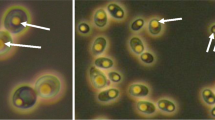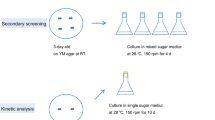Abstract
High cost of triacylglycerol lipid feedstock is the major barrier for commercial production of biodiesel. The fermentation of oleaginous yeasts for lipid production using lignocellulose biomass provides a practical option with high economic competitiveness. In this paper, the typical oleaginous yeast strains were screened under the pressure of lignocellulose degradation compounds for selection of the optimal strains tolerant to lignocellulose. The inhibitory effect of lignocellulose degradation products on the oleaginous yeast fermentation was carefully investigated. Preliminary screening was carried out in the minimum nutritious medium without adding any expensive complex ingredients then was carried out in the lignocellulosic hydrolysate pretreated by dilute sulfuric acid. Seven typical lignocellulose degradation products formed in various pretreatment and hydrolysis processing were selected as the model inhibitors, including three organic acids, two furan compounds, and two phenol derivatives. The inhibition of the degradation compounds on the cell growth and lipid productivity of the selected oleaginous yeasts were examined. Acetic acid, formic acid, furfural, and vanillin were found to be the strong inhibitors for the fermentation of oleaginous yeasts, while levulinic acid, 5-hydroxymethylfurfural, and hydroxybenzaldehyde were relatively weak inhibitors. Trichosporon cutaneum 2.1374 was found to be the most adopted strain to the lignocellulose degradation compounds.




Similar content being viewed by others
References
Pizarro, A. V. L., & Enoch, Y. P. (2003). Process Biochemistry, 38, 1077–1082. doi:10.1016/S0032-9592(02)00241-8.
Han, H. W., Cao, W. L., & Zhang, J. C. (2005). Process Biochemistry, 40, 3148–3151. doi:10.1016/j.procbio.2005.03.014.
Ma, F., & Hanna, M. A. (1999). Bioresource Technology, 70, 1–15. doi:10.1016/S0960-8524(99)00025-5.
Allen, C. A. W., Watts, K. C., Ackman, R. G., & Pegg, M. J. (1999). Fuel, 78, 1319–1326. doi:10.1016/S0016-2361(99)00059-9.
Leunc, D. Y. C. (2001). Water, Air, and Soil Pollution, 130, 277–282. doi:10.1023/A:1013883823851.
Tyson, K. S. (1998). NREL Technical Report, NREL/TP-580-24443.
Gerpen, J. V. (2004). NREL Technical Report, NREL/SR-510-36342.
Claassen, P. A., Sijtsma, L., Stams, A. J. M., de Vries, S. S., & Weusthuis, R. A. (1999). Applied Microbiology and Biotechnology, 52, 741–745. doi:10.1007/s002530051586.
Wahlbom, C. F., & Hahn-Hagerdal, B. (2002). Biotechnology and Bioengineering, 78, 172–178. doi:10.1002/bit.10188.
Parajo, J. C., Dominguez, H., & Dominguez, J. M. B. (1998). Bioresource Technology, 66, 25–40. doi:10.1016/S0960-8524(98)00037-6.
Palmqvist, E., & Hahn-Hagerdal, B. (2000). Bioresource Technology, 74, 25–33. doi:10.1016/S0960-8524(99)00161-3.
Klinke, H. B., Thomsen, A. B., & Ahring, B. K. (2004). Applied Microbiology and Biotechnology, 66, 10–26. doi:10.1007/s00253-004-1642-2.
Ratledge, C., & Wynn, J. P. (2002). Advances in Applied Microbiology, 51, 1–51. doi:10.1016/S0065-2164(02)51000-5.
Ray, F., Patricia, P., & Dlane, S. (1984). Applied and Environmental Microbiology, 47, 1130–1134.
Larsson, S., Quintana-Sainz, A., Reimann, A., Nilvebrant, N. O., & Jonsson, L. J. (2000). Applied Biochemistry and Biotechnology, 84/86, 617–632. doi:10.1385/ABAB:84-86:1-9:617.
Larsson, S., Palmqvist, E., Hahn-Hagerdal, B., Tengborg, C., Stenberg, K., Zacchi, G., et al. (1999). Enzyme and Microbial Technology, 24, 151–159. doi:10.1016/S0141-0229(98)00101-X.
Folsch, J., Lees, M., & Sloane-stanley, G. H. (1957). Journal of Biochemistry, 226, 449–509.
Kamm, B., Gruber, P. R., & Kamm, M. (2006). Biorefinery—Industrial processes and products. Weiheim: Wiley.
Acknowledgement
This research was supported by Ministry of Education of China (Grant No. 107123), PetroChina Co. Ltd (Grant No. 060511-4-7), and China National Special Fund for State Key Laboratory of Bioreactor Engineering (Grant No. 2060204).
Author information
Authors and Affiliations
Corresponding author
Rights and permissions
About this article
Cite this article
Chen, X., Li, Z., Zhang, X. et al. Screening of Oleaginous Yeast Strains Tolerant to Lignocellulose Degradation Compounds. Appl Biochem Biotechnol 159, 591–604 (2009). https://doi.org/10.1007/s12010-008-8491-x
Received:
Accepted:
Published:
Issue Date:
DOI: https://doi.org/10.1007/s12010-008-8491-x




